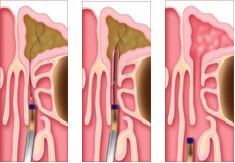

 |  |
PERFORMING BALLOON SINUPLASTY TREATMENT FOR CHRONIC SINUSITIS: First Provider in Suffolk County
Sinusitis affects 37 million people each year, making it one of the most common health problems in the United States. It significantly impacts an individual's physical, functional, and emotional quality of life. Patients suffer from headache, facial discomfort, nasal congestion, nasal drainage, loss of the sense of smell, and malaise.
Until recently, sinusitis patients were limited to two treatment options: medical therapy such as antibiotics and topical nasal steroids or conventional sinus surgery including functional endoscopic sinus surgery (FESS).
Medical therapy can help alleviate symptoms for some patients. However, for 20-25% of sufferers, this form of treatment alone is not adequate. For these patients, sinus surgery is their next hope in finding relief.
FESS is a conventional operation that requires bone and tissue removal in order to open up blocked sinus passageways. With no desirable treatment, more than 600,000 people nationwide are left living with their sinus condition.
Now there is an evolution in endoscopic sinus surgery using the newly developed balloon sinuplasty technology. Ghassan J. Samara, MD, assistant professor of surgery, is now using this technology to offer new hope in relief to chronic sufferers. He is the first physician in Suffolk County to treat patients with it.
Dr. Samara, who was trained and certified last fall in the use of balloon sinuplasty, says: "Sinuplasty provides a new tool for treating patients with chronic sinusitis that may not be severe enough for them to need FESS but in whom medications alone are insufficient. It offers patients considerable benefits, since it is minimally invasive and requires far less postoperative maintenance than FESS."
HOW IT WORKS
Endoscopic sinus surgery with this technology involves using a small, flexible balloon catheter that is placed through the nostril into the blocked sinus passageway. When the balloon is inflated, it gently restructures and opens the sinus passageway, restoring normal sinus drainage and function.

|
Step 1: Sinus guide catheter and a flexible sinus guidewire are placed through nostrils to access target sinus, and sinus balloon catheter is advanced over sinus guidewire. Step 2: Sinus balloon catheter is positioned across blocked sinus opening and gently inflated. Step 3: Balloon sinuplasty system is removed, leaving open sinus passageway and restoring normal sinus drainage and function. |
Balloon sinuplasty offers benefits to sinusitis patients considering surgery. This minimally invasive approach enables physicians to treat sinusitis entirely through the nostrils, and in many cases without tissue or bone removal. This may result in reduced bleeding and less post-procedure discomfort for patients.
Post-procedure, the size of the dilated opening is approximately that of the nominal diameter of the selected sinus balloon catheter (3-7 mm). While recovery time varies with each patient, many people can return to normal activities within 24 hours.
 For consultations/appointments with Dr. Samara, please call 631-444-4121.
For consultations/appointments with Dr. Samara, please call 631-444-4121.

| Back to Departmental News | Return to Home Page |